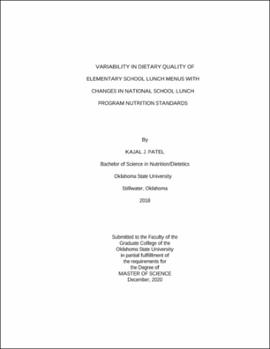| dc.contributor.advisor | Joyce, Jill | |
| dc.contributor.author | Patel, Kajal J. | |
| dc.date.accessioned | 2021-05-25T20:42:25Z | |
| dc.date.available | 2021-05-25T20:42:25Z | |
| dc.date.issued | 2020-12 | |
| dc.identifier.uri | https://hdl.handle.net/11244/329971 | |
| dc.description.abstract | Objective: There have been numerous changes to the National School Lunch Program (NSLP) nutrition standards over the past 10 years. The Healthy Hunger-Free Kids Act (HHFKA, 2010) presumably improved dietary quality (DQ) of reimbursable school meals from previous standards, while Child Nutrition Program Flexibilities (CNP Flexibilities, 2017) appear to decrease DQ. However, this variability in DQ has not been quantified. Thus, the purpose of this study was to determine differences in nutrient content and DQ between elementary school lunch menus meeting recent NSLP nutrition standards, School Meal Initiatives (SMI, 1995), HHFKA (2012), and CNP Flexibilities (2017), as well as with evidence-based school lunch best practices implemented (BP). | |
| dc.description.abstract | Methods: A base menu, deemed typical by expert opinion, was portioned per three versions of NSLP nutrition standards (SMI, HHFKA, CNP Flexibilities) and BP for elementary schoolchildren, and analyzed for nutrient content and DQ using ESHA Food Processor and The Healthy Eating Index (HEI) 2015. Statistical analyses included one-way ANOVA, Kruskal-Wallis, and Dunnett's test. The level of significance was set at p<0.0083. | |
| dc.description.abstract | Results: The BP menu had significantly higher whole fruit (317%) and whole grain (669%) HEI scores than the SMI menu. The BP and HHFKA menus had higher refined grain (156%) and added sugar (2%) HEI scores than the SMI menu. The SMI menu had lower total vegetable (49-50%) and saturated fat (43-51%) HEI scores compared to all other menus. Results were significant (ps<0.0083). | |
| dc.description.abstract | Conclusions: This study provides important information for guiding future policy towards further improving NSLP nutrition standards in their mission to provide healthy food to children, combatting malnutrition and obesity. Continuing to improve NSLP policy has the potential to impact the health, academic performance, and future of US children through higher DQ school lunches. | |
| dc.description.abstract | Funding Sources: None. | |
| dc.format | application/pdf | |
| dc.language | en_US | |
| dc.rights | Copyright is held by the author who has granted the Oklahoma State University Library the non-exclusive right to share this material in its institutional repository. Contact Digital Library Services at lib-dls@okstate.edu or 405-744-9161 for the permission policy on the use, reproduction or distribution of this material. | |
| dc.title | Variability in dietary quality of elementary school lunch menus with changes in National School Lunch Program nutrition standards | |
| dc.contributor.committeeMember | Amaya, Lauren | |
| dc.contributor.committeeMember | Hildebrand, Deana | |
| osu.filename | Patel_okstate_0664M_16634.pdf | |
| osu.accesstype | Open Access | |
| dc.type.genre | Thesis | |
| dc.type.material | Text | |
| dc.subject.keywords | child nutrition | |
| dc.subject.keywords | child nutrition program | |
| dc.subject.keywords | dietary quality | |
| dc.subject.keywords | healthy | |
| dc.subject.keywords | hunger-free kids act | |
| dc.subject.keywords | national school lunch program | |
| dc.subject.keywords | nutrition policy | |
| thesis.degree.discipline | Nutritional Sciences | |
| thesis.degree.grantor | Oklahoma State University | |
